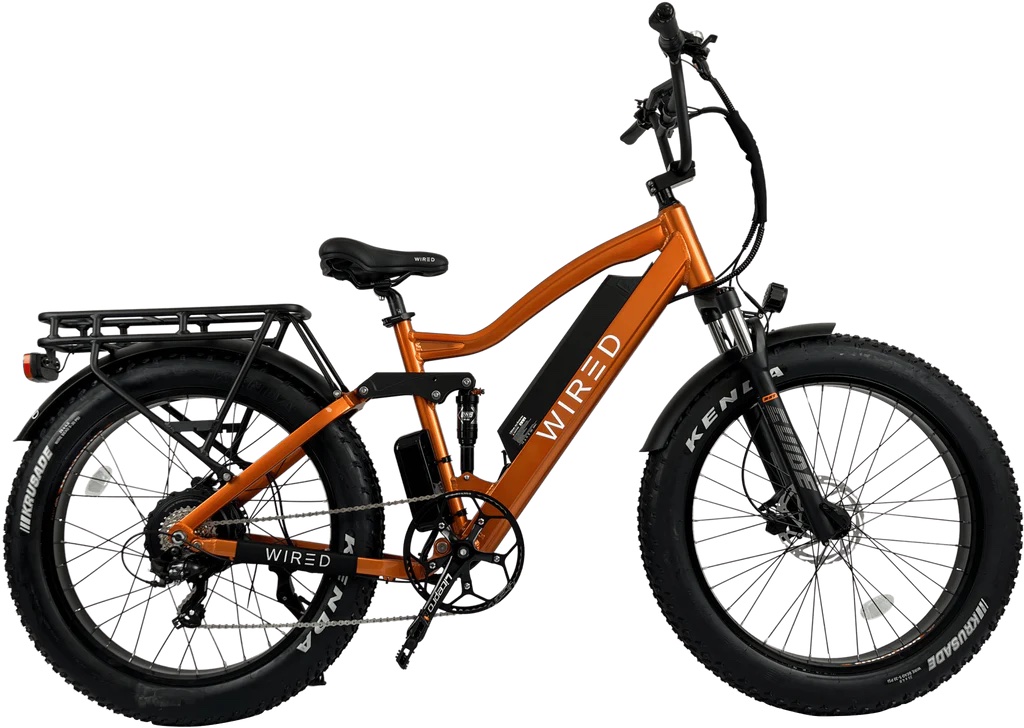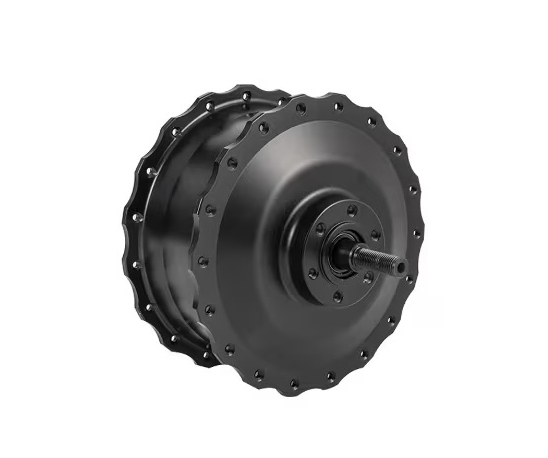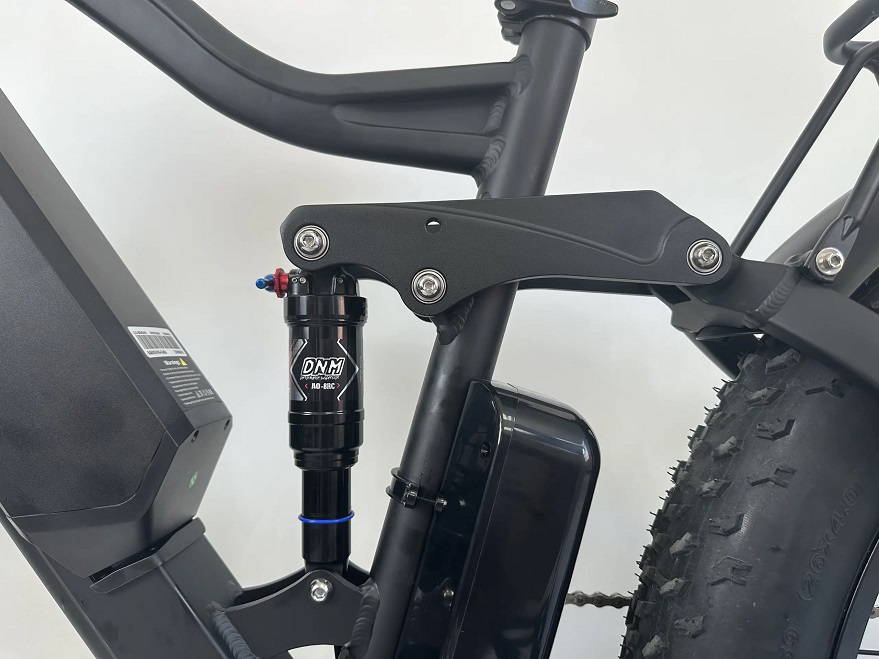
Intro
The e-bike market is dominated, if not ruled, by two competing trends. One is to make e-bikes more affordable. Yay! The other is to build ever-more-powerful e-bikes. Wired Ebikes is working both of these angles with their Freedom all-terrain e-bike. They’ve created one of the most powerful e-bikes on the market and it is remarkably affordable. In our Wired Freedom review we will take a deep look at what makes this e-bike unusual.
If the Wired name doesn’t immediately ring a bell, Wicked might. They recently underwent a name change following a complaint from an e-motorcycle manufacturer named Wicked. So now the brand is known as Wired and we’re looking at the model called the Freedom.
The Wired Freedom is unusual even among the more powerful e-bikes we see. Courtesy its 1500W (that’s nominal, not peak wattage) hub motor, this e-bike offers riders literally double the power of most of the more powerful e-bikes we see. And with such a big motor, it needs a battery to match, which it has, thanks to the 1200Wh semi-integrated battery.
Outside of those two features, the Wired Freedom looks like many all-terrain e-bikes we’ve reviewed in the past. It comes equipped with 4-in.-wide tires, a 7-speed Shimano drivetrain, Tektro hydraulic disc brakes, plus a full commuter package including front and rear lights, fenders, a rear rack and kickstand.
We have been seeing e-bikes that give their owners the opportunity to choose between Class 1, 2 or 3 performance for some time; but now we are also seeing an increasing number of e-bikes that allow for unrestricted riding, sometimes called off-road mode. These e-bikes allow their riders to either pedal or throttle their way to speeds above 28 mph. An e-bike that goes faster than 28 mph falls into a gray area, legally, but we will come to that later.
Most of the all-terrain e-bikes we review feature a suspension fork paired with a hard-tail or rigid frame. One of the nice features about the Wired Freedom is its full-suspension frame. This frame design will do more to ensure rider comfort in the saddle than any other component selection can.
There’s lots to consider here, so let’s dive in.

E-Bike Category: All-terrain
Who the Wired Freedom Electric Bike Is for: This is for the rider who wants to be able to explore backroads and natural surface trails, but also wants maximum speed, acceleration and climbing ability.
Wired Freedom Electric Bike Review Ratings:
***All ratings are relative to e-bikes of a similar style and price point***
| Speed/Acceleration | 5 5 |
| Hill Climbing | 5 5 |
| Battery Range | 4.8 5 |
| Braking | 3.8 5 |
| Construction Quality | 4.6 5 |
| Handling | 4.5 5 |
| Included Accessories | 3.8 5 |
| Warranty | 2 5 |
| Value | 4.8 5 |



Wired Freedom E-Bike Specs
- Battery: 60V, 1200Wh lithium-ion, Samsung cells
- Expected Range: Up to 60 mi. in PAS 1, estimated
- Charger: 60V, 3A
- Motor: 1500W Hengtai brushless, geared hub motor, 138Nm of torque
- UL Certification: Not yet, but in the works.
- Pedal Assist: 5 PAS levels
- Throttle: Included
- Display: Programmable, color LED
- Headlight: 180 Lux
- Taillight: Included
- Frame: 6061 hydroformed aircraft aluminum with rear shock
- Fork: 75mm-travel RST suspension fork
- Fenders: Included
- Kickstand: Included
- Handlebars: BMX-style alloy riser bar
- Grips: Rubber
- Drivetrain: 7-speed Shimano, 56t chainring, 11-34t cassette
- Brakes: Tektro hydraulic disc brakes, 180mm rotors
- Pedals: Alloy with reflectors
- Saddle: Included
- Tires: 26 x 4-in. Kenda or Chaoyang knobby

In-Depth Wired Freedom Review
Wired Freedom Review: Comfort, Handling, and Ride Qualities
The Wired Freedom, like most consumer-direct e-bikes, comes in a single size. Wired suggests the size range for the Freedom runs from 5 feet 4 up to 6 feet 4. That’s optimistic in our experience. There are two measurements that riders should be aware of before buying this e-bike.
The first measurement is the standover height, which figures 29.7 in. That means someone needs at least a 30-in. inseam to stand over this e-bike with comfort. That will leave out most of the population less than 5 feet 9 inches tall.
The second measurement is the top tube length, a rather roomy 23.4 in. Again, riders who aren’t reasonably tall are going to struggle to reach the handlebar from the saddle. The question isn’t whether someone can reach that distance; most folks will be able to. The question is whether someone will be comfortable leaning forward that much.
The good news is that the BMX-style riser bar can be tilted back toward the rider some to reduce that reach.
The Wired Freedom features a full-suspension frame paired with a 75mm-travel fork and 26-in. wheels that roll on 4-in.-wide tires. It would be difficult for them to come up with a design that does more to give the rider a cushy experience.
This is an all-terrain e-bike, meant to go places most other e-bikes (save for eMTBs) aren’t designed to explore. It will make riding on uneven or poorly graded dirt roads NBD.
At 88 lbs., this is one of the heavier e-bikes we’ve seen, heavier than most e-trikes. It’s a heavyweight for a few reasons, all of them understandable. First, it features a powerful motor and a huge battery—more on those in a sec—plus a full-suspension frame and a suspension fork. Those four features are why this is an 88-lb. e-bike rather than a 68-lb. one.
With so much weight rolling, this is an e-bike that will be happiest moving in a straight line. It will be stable, but won’t enjoy all of the maneuverability of some e-bikes. That said, riders are likely to feel more secure and confident at speed than they would on many other e-bikes.
Wired Freedom Review: Motor, Battery, and Drivetrain Performance
Wired proclaims that the Freedom e-bike comes with the biggest battery available in the e-bike market, a 60V, 20Ah (1200Wh) monster that uses high-quality Samsung cells. Certainly, if someone is going to own an e-bike with such a big battery, knowing that it uses some of the best cells available is reassuring.
We can confirm that it is the biggest battery on the market, but we can say it is the biggest we’ve encountered. And it’s huge, physically, as well, contributing 10 lbs. to the Freedom’s overall weight of 88 lbs.
So why have such a big battery? Well, the motor is so powerful that without such a ginormous battery, the Freedom would offer a rider very little range. So how powerful is the motor? The Hengtai brushless, geared hub motor produces 1500W, nominally, and peaks at a stunning 2200W. To put this in perspective, most 750W-rated hub motors don’t even produce 1500W at peak. Not only is this the biggest battery we’ve seen on an e-bike, this is the most powerful motor we’ve seen.
Compared to the Super73-S2 we recently reviewed, which comes with a 750W motor that peaks at 1200W and can deliver riders to speeds north of 28 mph on throttle alone, the Wired Freedom offers double the nominal wattage of the Super73-S2 and an extra 1000W at peak.
Of course, a motor’s wattage is but one measure of power. Voltage is another, and most e-bikes with a hub motor are rated at 48V; a few come rated at 52V, so the Wired Freedom’s 60V system is, to use the hose metaphor, what firefighters use as opposed to the garden hose of most systems.
Another measure is the motor’s torque, which comes in at 138Nm. This isn’t the highest torque rating we’ve seen, but when paired with 60V circuitry, we’re willing to bet that it will be difficult to find another e-bike that can accelerate and climb with as much verve. This is the e-bike for NHRA members.
Most e-bike motors feature nylon gears to help reduce weight and to quiet the motor’s operation. Unfortunately, nylon gears can and will wear out, and the greater the motor’s power (and especially torque), the faster that can happen. The Hengtai motor uses steel-reinforced gears to increase the motor’s lifespan, but such gears do tend to produce a bit more noise.
Because the motor is so powerful, Wired suggests that riders can hope to see as much as 60 mi. of range, so long as they stay in PAS 1. Riders who want to take advantage of the Wired Freedom’s full power will see substantially less range than that.
We’ve encountered a number of e-bikes that proclaim they can be unlocked to be ridden as Class 3 e-bikes with a maximum pedal-assist speed of 28 mph. But some of these e-bikes come with a hitch. Their drivetrain’s highest gear is too small for the average person to pedal at 28 mph, kinda like trying to use a gear for hills on flat ground.
The Wired Freedom does not suffer this oversight. It comes with a whopper of a chainring—56t—and a wide-range 11-34t cassette. That top gear—56 x 11—is big enough to pedal down mountain passes at speeds north of 40 mph. Riders will not have any trouble reaching full mach with the Wired Freedom. And kudos to them for choosing such a wide-range cassette (310 percent); we hardly ever see such a wide-range cassette spec’d with 7-speed drivetrain.
When the Wired Freedom ships, it arrives at the buyer’s home set for Class 2 riding (20 mph pedal assist and 20 mph limit to throttle). It can be set to perform as Class 1 (no throttle and 20 mph max assist), Class 3 (28 mph max assist) or unlocked. In unlocked mode it can assist riders up to a possible max of 35 mph.
Things happen really quickly at 35 mph; a rider has very little reaction time at that speed, so we encourage some caution when considering an e-bike that can go this fast. Another point to consider is that wind resistance is a “squared function” in the parlance of physics. What that means is that the amount of power required to go faster increases at an exponential rate, so while going 28 mph will draw down a battery in a hurry, going 35 mph will see range shrink by an astonishing amount.
Wired Freedom Review: Braking, Safety & Warranty
With so much power on tap with the Wired Freedom, hydraulic disc brakes are a must-have. Wired chose the Tektro E-350 brakes and paired them with 180mm rotors. This is arguably the single most popular brake being used on e-bikes; we know it to be reliable and powerful. We also know this brake primarily from being spec’d on Class 2 e-bikes that only go faster than 20 mph when going downhill.
Because the Wired Freedom has the power necessary to offer riders power to speeds as high as 35 mph, we would have preferred to see either larger rotors (203mm is the largest rotor size made for bikes) or the Tektro E-350 two-piston calipers replaced with ones with four pistons. The stopping distance for an e-bike going 30 mph is notably longer than at 20 mph. A more powerful brake setup would help to shorten that distance and the 4-in.-wide tires offer traction enough to take advantage of more braking power.
There’s nothing in the design of this e-bike that raises the red flag concerning safety. That said, we suggest some consideration and caution when considering an e-bike that can offer pedal assistance to speeds above 30 mph. On empty backroads with good sightlines, sure, why not? But when riding along with traffic, most drivers will not be expecting to see someone on an e-bike move that quickly, which could cause, uh, problems.
Wired’s warranty lasts for a single year, which is the bare minimum we see. They do offer an extended warranty for $199, which adds another year.
Wired Freedom Review: Recommendation/Final Verdict
The simple fact that an e-bike like the Wired Freedom is on the market at the $2000 price point speaks to how technology comes down in price as time goes on. Anyone remember the Apple 2e? The product managers who work for e-bike companies work hard to figure out how to pack as much value as possible into an e-bike. The need to meet a predetermined price point makes the job even harder. The Wired Freedom is the result of some very shrewd work.
When compared to other e-bikes in this price range, we can see what sorts of trades Wired made in order to deliver an e-bike with a 1500W motor and a 1200Wh battery. Rather than go with a motor from a well-known manufacturer like Bafang, they went with a lesser known manufacturer, Hengtai. Most e-bikes in this price range feature an 8-speed drivetrain, usually from Shimano, which includes an easy-to-use trigger shifter.
Another notable difference we see between the Wired Freedom and some competing models is that we often see companies offer two frames (traditional and step-thru) and sometimes even more than one size. Producing just one size and frame style helps to keep costs down.
Regarding riding the Wired Freedom in off-road mode, we have a duty to mention that this and similar e-bikes can be ridden legally in off-road mode at Off-Highway Vehicle (OHV) areas, but when it comes to riding it on city streets it isn’t legal, unless the rider switches to the applicable acceptable mode (Class 1, 2 or 3). Not to be a downer, but even Class 2 (throttle to 20 mph) and Class 3 (pedal assist to 28 mph) are often restricted in terms of where they can ride, such as not being permitted on most bike paths. We’re all grownups and can decide how we feel about speed limits, which is what the three-class system is, to a certain degree.
This can seem a little nanny-state, but the bike industry veterans who worked to create the three-class system came up with those guidelines so that municipalities across the country wouldn’t simply determine all e-bikes were illegal, which was a looming threat some years back. Rider safety was a big consideration. For perspective, bike helmets are designed to prevent or at least lessen the severity of head injuries to riders going 20 mph or less. A bike helmet offers underwhelming protection at 35 mph.
So what happens if someone buys the Wired Freedom and runs it as a Class 1 e-bike so that it is legal anywhere e-bikes can be ridden? Does that ruin the experience? Nope. Limiting top speed to 20 mph does nothing to its acceleration or its ability to climb. With this e-bike a rider can beat many cars through an intersection upon seeing that green light. This would still be a marvelously fun e-bike.
As we mentioned earlier, we don’t see too many all-terrain e-bikes that come with full suspension. This can make off-road riding much more enjoyable. We would encourage Wired Freedom buyers to visit a bike shop for help setting up the suspension so that it works properly; the rear shock features an air spring, so the air pressure inside determines how well it works for the rider; a bike shop will set the pressure relative to the rider’s weight. Properly adjusted suspension isn’t just comfortable; it makes the e-bike easier to control, and for anyone who wants to try the Wired Freedom in off-road mode, proper suspension setup will make the e-bike handle better both on-road and off-road.
For the rider who wants to explore wild spaces, make a lengthy round-trip commute, run errands that require the ability to load things on the rear rack or simply ride on rough roads without their eyes bouncing, the Wired Freedom is a thrilling option. With such impressive acceleration and climbing ability, combined with big tires and full suspension, this is an e-bike that will make even a run to the market memorable.
Thank you for reading through our review of the Wired Freedom. Still have further questions? Wondering how it compares to a similar e-bike we’ve reviewed? Let us know in the comments below!




Leave a Reply